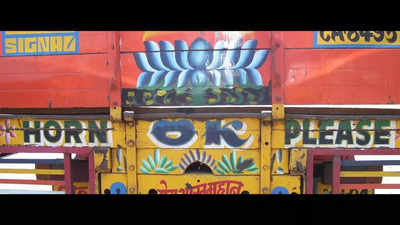Horn ok please
If you’ve travelled across India’s highways, you’ve likely noticed a unique cultural phenomenon: trucks adorned with colourful artwork, poetry, and slogans. Among these eye-catching details, one phrase is almost ubiquitous — “Horn OK Please.” This seemingly simple phrase has become an intrinsic part of Indian highway culture, sparking curiosity an
d intrigue for years. It even inspired a Bollywood movie. But where did it come from, and what does it really mean?Despite its popularity, “Horn OK Please” is not mandated by law, nor does it carry any official significance. Yet, it persists across highways, with various theories attempting to explain its origins. One popular explanation traces the phrase back to World War II, during a time when India, like many other countries, faced a severe diesel shortage. Trucks often transported kerosene — a highly flammable substance — in place of diesel. To caution other drivers of the hazardous load, the phrase “On Kerosene” was painted on the trucks.
Over time, this warning supposedly evolved into the abbreviation “OK,” which was then incorporated into the now-famous phrase.Another theory connects the phrase to a marketing campaign by the TATA Group. TATA, primarily known for steel, trucks, and hotels, had introduced a budget soap brand named “OK” to compete with the popular Lifebuoy soap. Some believe that “OK” was painted on trucks as part of a clever advertising strategy, further embedding the term into popular culture.Though the origins of the “OK” in “Horn OK Please” are debated, the phrase itself serves a clear purpose on the roads. Historically, many trucks in India were not equipped with side mirrors, which meant that drivers could not easily see the vehicles trailing behind them. “Horn OK Please” essentially functioned as a message to drivers following the truck: honk your horn if you intend to overtake.
In a country where roads can be chaotic and communication between drivers is crucial for safety, the phrase became a practical tool. By encouraging the use of the horn, truck drivers could be made aware of approaching vehicles, thereby facilitating safer overtaking manoeuvres.Cultural legacy of “Horn OK Please”
While modern trucks are now equipped with side mirrors and better safety features, “Horn OK Please” continues to appear on the backs of vehicles across the country. What began as either a safety measure or a marketing gimmick has since become a symbol of India’s vibrant and diverse road culture. It speaks to a time when simple phrases helped foster communication on the country’s sprawling highways.
Despite the advancement of technology and transportation infrastructure, this iconic phrase remains a staple of Indian roadways, continuing to pique the interest of curious onlookers and preserving a unique piece of highway folklore.
“Horn OK Please” has become an enduring symbol of India’s colorful highway culture. Whether it started as a safety warning or a marketing strategy, the phrase reflects the importance of communication on the roads. Today, it remains a familiar and nostalgic reminder of India’s unique driving traditions.
